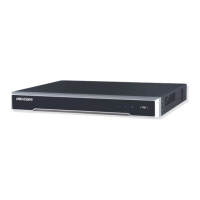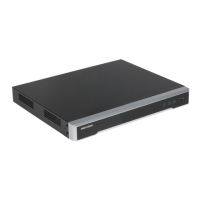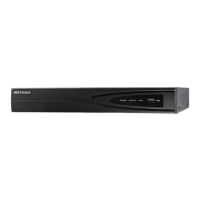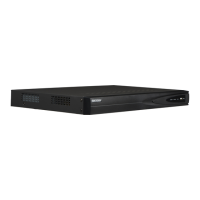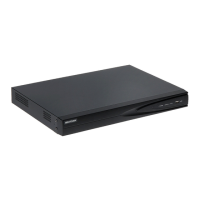Do you have a question about the HIKVISION DS-7616NI-E2/16P and is the answer not in the manual?
| Model | DS-7616NI-E2/16P |
|---|---|
| Channel Input | 16 |
| Max. Incoming Bandwidth | 160 Mbps |
| Video Compression | H.265+/H.265/H.264+/H.264 |
| Decoding Format | H.265/H.264 |
| USB Interface | 2 USB 2.0 |
| Alarm In/Out | 16/4 |
| Operating Humidity | 10% to 90% |
| Type | Network Video Recorder |
| IP Video Input | Up to 16 IP cameras |
| Audio Compression | G.711 |
| HDMI Output | 1 HDMI |
| VGA Output | 1 |
| Audio Output | 1 |
| Recording Resolution | 1080p/720p/4CIF/DCIF/2CIF/CIF/QCIF |
| Network Interface | 1 RJ-45 10/100/1000 Mbps self-adaptive Ethernet interface |
| PoE Interface | 16 |
| Supported Standard | ONVIF |
| Power | 100-240V AC |
| Power Supply | 100 to 240 VAC, 50 to 60 Hz |
| Operating Temperature | -10°C to +55°C (14°F to 131°F) |
| Weight | 3.5 kg |
| Synchronous Playback | 16 |
| Capability | 16-ch |
Description of the control panel buttons for the DS-8600NI-E8 series.
Instructions for operating the NVR using the included IR remote control.
Details on using a 3-button USB mouse for NVR control.
Explanation of the soft keyboard icons and their functions.
Description of the rear panel interfaces for various NVR models.
Procedure for properly starting up and shutting down the Network Video Recorder.
Instructions for setting a strong administrator password for first-time access.
Guide to configuring and using an unlock pattern for device login.
Walkthrough of the setup wizard for basic NVR configuration.
Procedures for logging into and out of the NVR device.
Steps for activating and adding IP cameras to the NVR system.
Overview of the Live View mode and its icons.
Description of functions available in Live View mode.
Customizing Live View settings like output interface and dwell time.
Enabling channel-zero encoding for reduced bandwidth in remote views.
Procedure to set PTZ parameters for controlling PTZ cameras.
Guide to setting and managing PTZ presets, patrols, and patterns.
Overview and description of the PTZ control panel icons.
Defining parameters affecting image quality, resolution, and stream type.
Setting up schedules for automatic recording based on time and event.
Setting motion detection parameters to trigger actions like recording.
Configuring recording triggered by external alarm inputs.
Configuring recording triggered by various Video Content Analysis (VCA) events.
Steps for manually starting and stopping recording.
Setting up recording schedules specifically for holidays.
Enabling redundant recording for enhanced data safety and reliability.
Grouping HDDs to save record files in specific HDD groups.
Methods to protect recording files from being overwritten.
Procedures for playing back recorded files using various search methods.
Additional playback features like frame-by-frame and thumbnail views.
Steps for exporting record files to backup devices quickly and normally.
Management of backup devices like USB flash drives and HDDs.
Configuring motion detection parameters and alarm response actions.
Setting handling actions for external sensor alarms.
Configuring detection and response actions for video loss.
Setting video tampering detection and alarm response actions.
Configuring handling actions for various system exceptions.
Defining actions like event hints, full screen monitoring, and audible warnings.
Manually triggering or clearing alarm outputs.
Configuring face detection parameters and rules.
Setting up vehicle detection rules for traffic monitoring.
Configuring rules for detecting objects crossing a virtual line.
Setting rules for detecting objects entering or loitering in a virtual region.
Configuring rules for detecting objects entering a defined virtual region.
Configuring rules for detecting objects exiting a defined virtual region.
Setting rules for detecting objects loitering in a virtual region.
Configuring rules for detecting groups of people in a virtual region.
Setting rules for detecting fast-moving objects in a virtual region.
Configuring rules for detecting illegal parking in specific areas.
Setting rules for detecting unattended objects in a defined region.
Configuring rules for detecting objects removed from a defined region.
Setting rules for detecting abnormal audio events like sound intensity changes.
Configuring rules for detecting sudden changes in the surveillance scene.
Setting rules for detecting image defocus or blur.
Configuring rules for Passive Infrared (PIR) alarms.
Searching for captured face pictures and related video files.
Searching for suspicious behavior based on VCA detection.
Searching for vehicle plate pictures based on specific conditions.
Calculating and reporting people counts in configured areas.
Generating heat maps to analyze customer visit times and dwell times.
Configuring basic network parameters like IP address and working mode.
Configuring advanced network features like PPPoE, DDNS, and Cloud P2P.
Monitoring real-time network traffic information such as linking status.
Obtaining network connection status, delay, and packet loss.
Procedure for initializing a newly installed hard disk drive (HDD).
Adding and managing allocated NAS or IP SAN disks as network HDDs.
Organizing multiple HDDs into groups for recording.
Allocating storage quotas for recorded files per camera.
Checking the status of installed HDDs for monitoring and maintenance.
Performing HDD detection using S.M.A.R.T. and Bad Sector Detection.
Setting up alarms for HDD errors or abnormal status.
Customizing on-screen display settings like date, time, and camera name.
Setting up privacy mask zones to obscure specific surveillance areas.
Adjusting image parameters like brightness, contrast, and saturation.
Accessing and viewing system information for the NVR device.
Searching and exporting operation, alarm, and exception log files.
Importing and exporting IP camera configuration data.
Exporting NVR configuration for backup or importing to other devices.
Instructions for upgrading the NVR firmware using backup devices or FTP.
Procedure for restoring NVR settings to factory defaults.
Configuration settings for the RS-232 serial port.
Configuring general device settings like language and resolution.
Setting up Daylight Saving Time (DST) adjustments.
Adjusting device parameters such as device name and auto logout.
Adding, deleting, and editing user accounts and permissions.
Technical specifications for various NVR models.
Definitions of technical terms and acronyms used in the manual.
Solutions for common problems and issues encountered with the NVR.
Overview of updates and changes across different software versions.
Lists of compatible Hikvision and third-party IP cameras.



